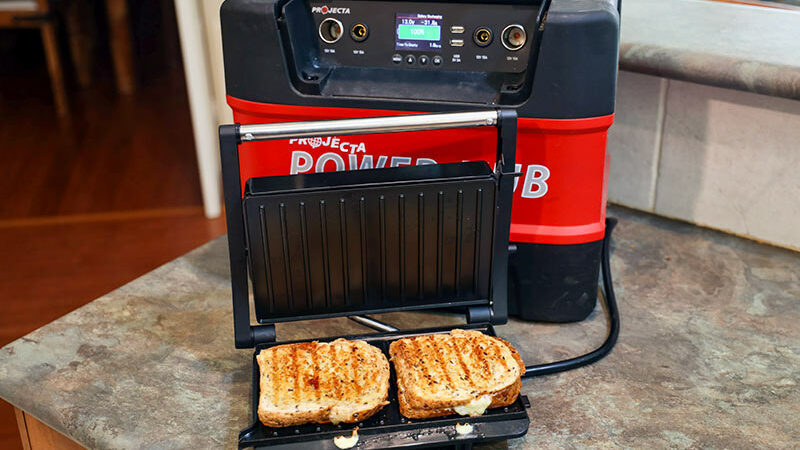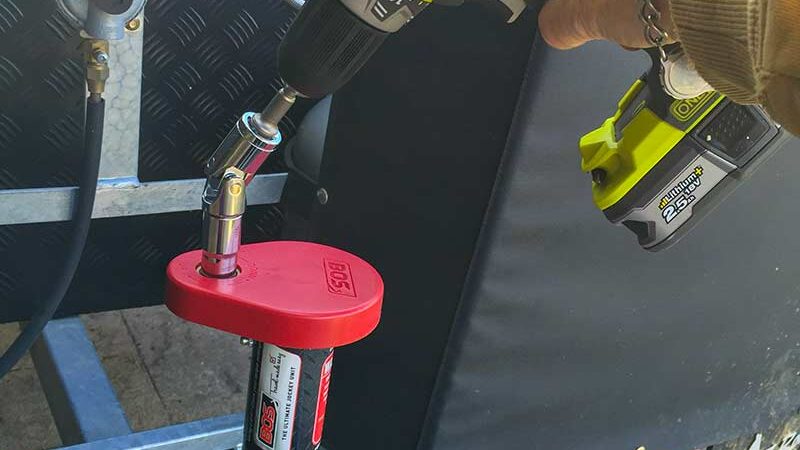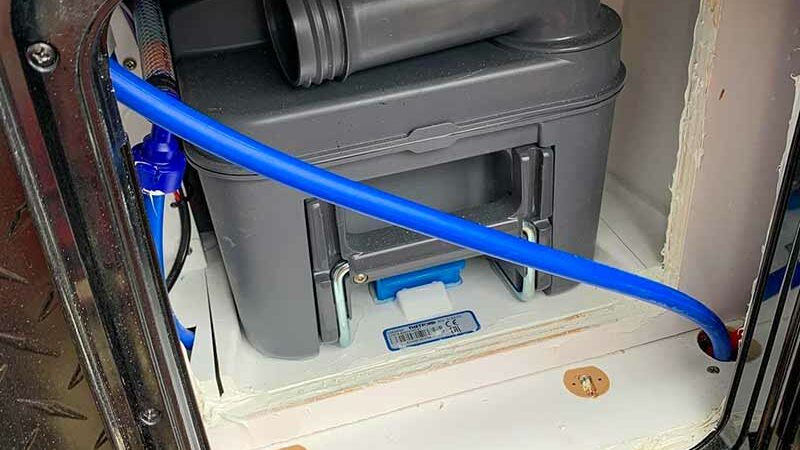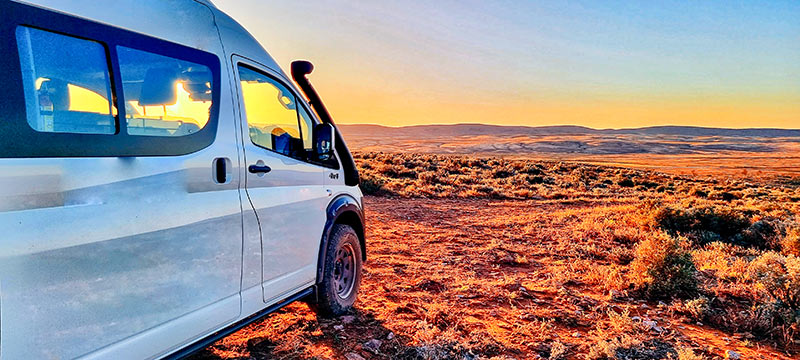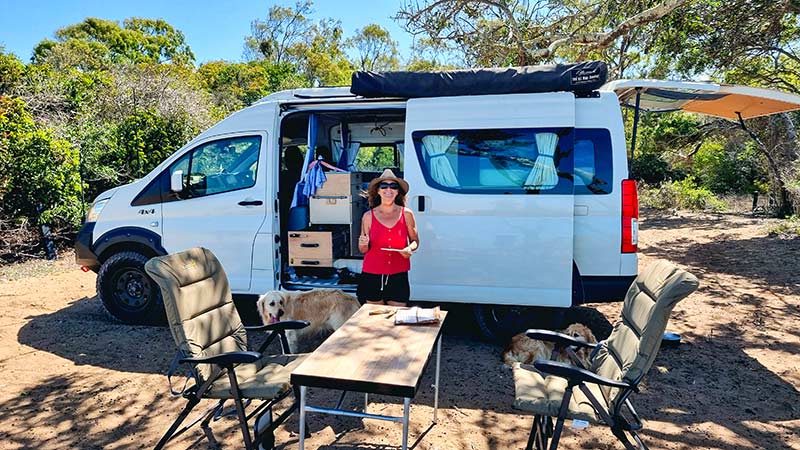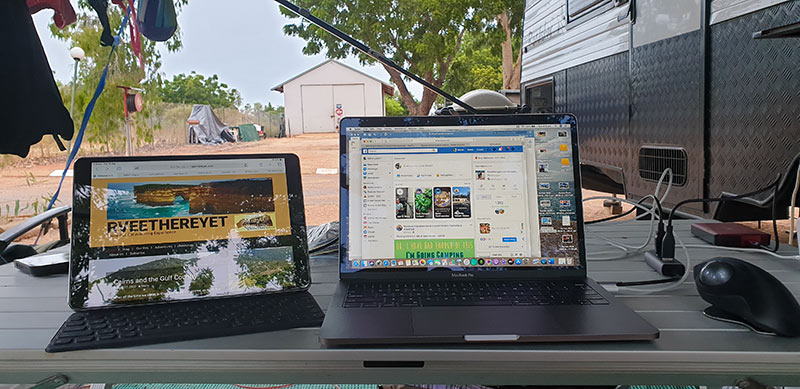Campfire Cooking Tips
Being on the road is great at any time in our books, but sometimes we look forward to when we don’t need to park next to a power pole or have running water from a town tap. When we are camping unplugged, we like to take things one step further by cooking and preparing meals over our campfire. The result can be very soothing for the soul (but far better for our stomachs!) If you’re like us, you’ll agree that everything seems to taste better when it’s cooked over a fire.
The choice of cooking accessories these days is almost endless. You’ve only got to walk around the accessories section at a caravan and camping show to find a vast selection of campfire cooking utensils, pots/pans, plus the latest cooking gadgets on offer. We think that over the years, we have probably tried them all at one stage or another.
These days, we have stripped things back to basics for cooking over fire. This type of cooking can be both fun and rewarding, so let’s look at a few different campfire accessories to whet your appetite, so to speak.
FOLD-UP CAMPFIRE BARBECUE
One of the simplest ways to cook over a fire is to use a humble barbecue. All you need is to place a hot plate of sorts over some nice coals, add a few snags or something along those lines, and you’re well on your way to some delicious fare.
While there are different styles of barbecues to choose from, a compact fold-up style that’s half hot plate and half a grill is our pick. It’s just the perfect bit of gear when there’s only two of us.
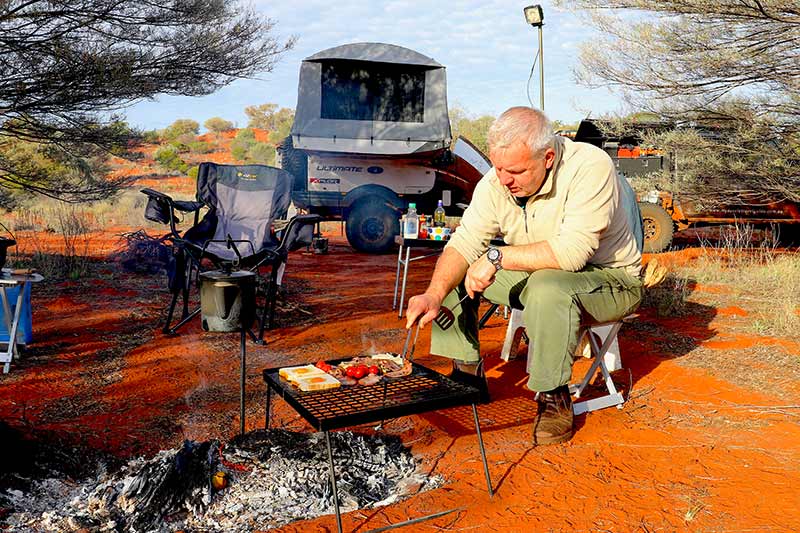
Our barbecue’s folding design incorporates a plate and grill that fold together (along with the legs), so it’s far from bulky. The barbecue also comes with a small carry handle. We also like that it has a small lip, which makes the plate and grill slightly recessed. The last thing you want is to lose what you’re cooking over the side where it could end up in the mouths of ants!
The beauty of this style of barbecue is you don’t need a roaring fire. You only need to dig a small fire pit and straddle the barbecue over the fire at one end. Should you need the plate or grill to be positioned closer to the fire source, simply dig a small trench either side of the fire and place the barbecue legs into the trenches.
Whether you’re cooking a big breakfast, flipping pancakes, or making a meal with your favourite meat or veggies, these barbecues work well. Their height and size are spot-on for plonking yourself on a small stool while cooking up a storm to save yourself from any bending. So no complaints from us. After a quick wipe with some paper towel once you’ve finished cooking, the barbecue will be all ready to go for your next cook-up.
CAMP OVENS
I don’t think we’d be alone when saying a camp oven-cooked meal would be one of the best things about a camping trip. Whether you’re dining on a homestyle stew, homemade bread, damper, scones, or even pizza, you can whip up all these delicious dishes with a little practise.
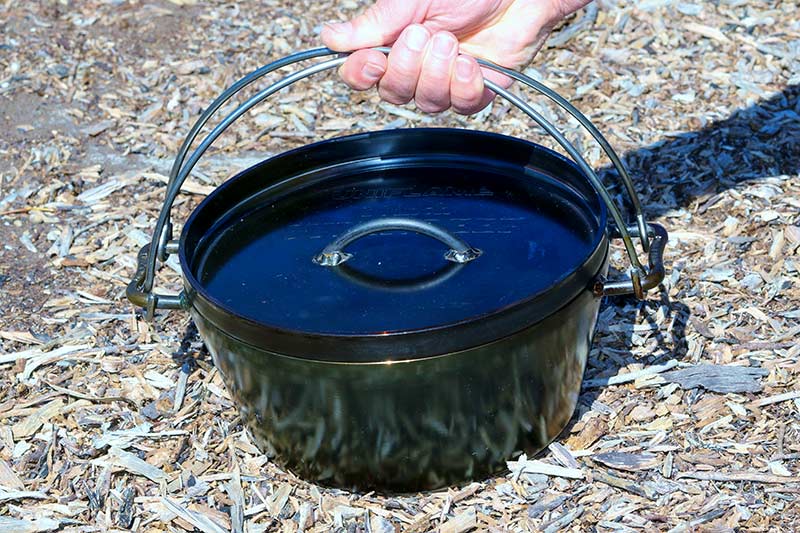
Camp ovens come in different sizes and features, plus they’re an excellent cooking source as they retain the heat. The more popular type of camp oven is made of spun steel, while the more traditional types are cast iron.
Cast iron camp ovens have been around for ages. There’s no denying they’re heavier than other types, but many cast iron cooking die-hards will say you just can’t go past their good quality and reliability. Spun steel camp ovens are the newer kid on the block, they come in various sizes, and are lighter than their heavy cast iron brothers.
You’ll find the quality of the steel and the thickness of the camp oven’s walls play a part when it comes to longevity and cooking quality. However, being lighter than cast iron is an advantage when you’re looking to save weight while travelling. On the flip side, you need better control with spun steel because of heat transfer.
BILLY HOOK
This type of fire accessory has become one of our all-time favourites to travel with in recent years. After a close friend allowed us to copy his billy hook design, it was a quick trip to the hardware for some steel followed by a day in the shed using some hand tools and a welder.
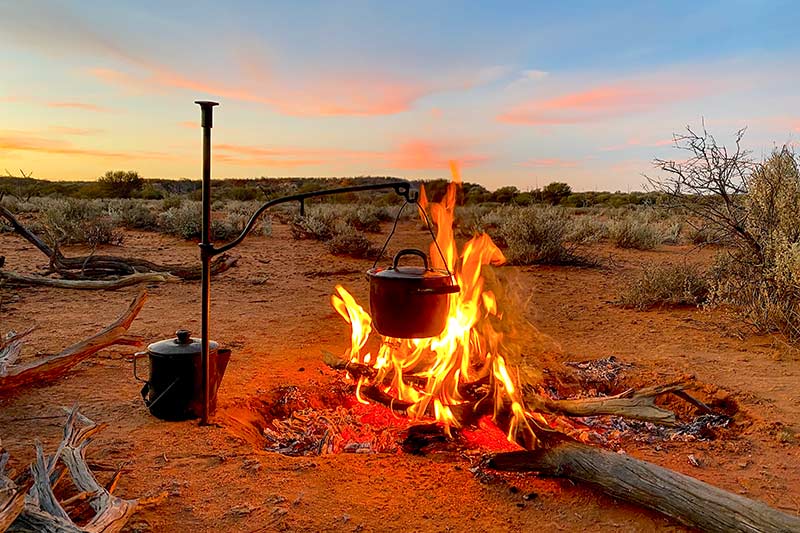
Basically, it’s our go-to accessory when we’re looking to boil a billy, bring a pot of water to the boil, or just let the pot simmer.
The billy hook is made of a few components and very easy to assemble. It all starts with a 12mm hardened construction peg for the stand. This piece gets hammered into the ground to the side of the fire pit to hold it in place. A small piece of steel rod that’s formed into the shape of a hook is used to make the hook for the stand.
A piece of pipe is then welded to the rod hook, which allows it to slide up and down the construction peg. That way it can be positioned either closer or further away from the heat as required.
It’s a simple design concept, with the weight of the hook and what’s hanging on it helping to keep it in position on the construction peg. You can swing the hook in and out of the fire, have it roaring a few inches above the heat, or simply lift it up and placed to the side to simmer. This technique also prevents ash getting on the billy and is good for controlling how you use the heat from the fire.
A SIMPLE POT
You might find this one a little left field, as the pot we love to use comes from Ikea. No, Ikea does not have a new camping range, but it’s something we picked up out of its kitchen section. It’s a stainless steel pot that comes with a recessed stainless steel lid that has proven to be very useful for camping.
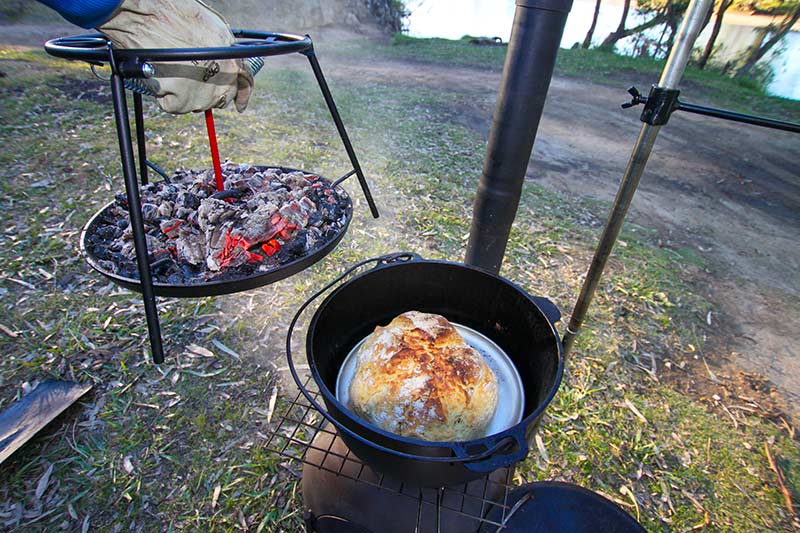
We were looking for something that was bigger than our billy, but not too big and heavy that it wouldn’t work on the billy hook. With a couple of holes drilled in the pot’s handles and bending some heavy-gauge fencing wire so it could be hung, it now works a treat on the billy hook. Just like a regular billy, it’s easy to control how it’s used on the fire, i.e., for a rolling boil or a gentle simmer.
It’s a multi-use pot that’s a good size if we’re travelling with pre-cooked vacuum sealed meals that we simply need to heat and eat. To top things off, we use the pot’s clean hot water for doing the washing so no water is wasted.
If you consider using a pot like ours, stay clear of any pots that have glass lids, which could potentially break while you’re travelling.
GRATE
Things also don’t get much simpler when you use a small grate on a campfire. These can really be used for all sorts of things. Whether you’re toasting some bread, cooking a steak, stabilising a pan, or even just heating a can of vegetables or soup, this little guy delivers the lot.
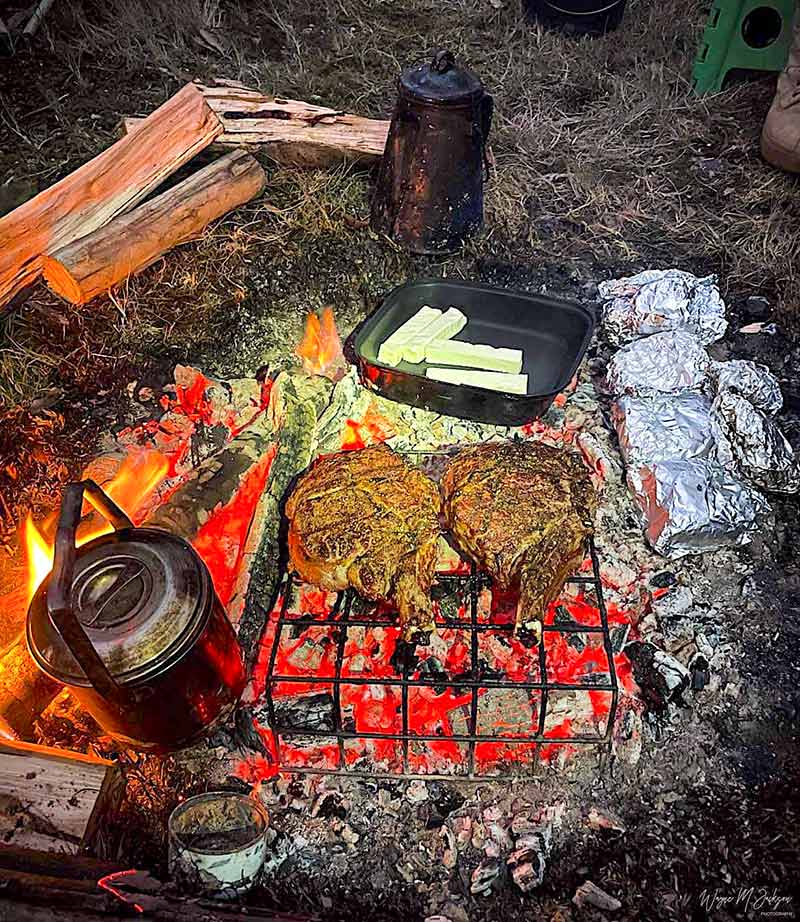
You only need to dig a small hole in the ground next to your main fire and drop in a shovelful of coals. Place the grate on top and you have your campfire burner ready to go. Sure, you can buy fancy fold-up grates that come with small legs, but why not save a few dollars by using some reinforcing mesh and shape it to your desired size?
They’re grate (err… great) when you just want a stable surface to work off, as they’re small, compact, and simply work.
SUMMING UP
There are many lifestyle advantages to having a campfire wherever you are, and a delicious meal cooked on a campfire just tops the experience off nicely. As a bonus, we’ve always found a campfire naturally brings people together.
The post Campfire Cooking Tips appeared first on GoRV.

